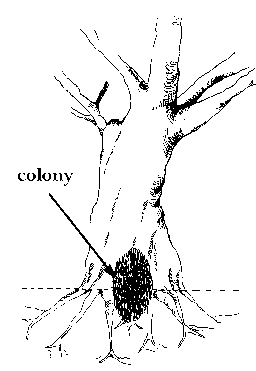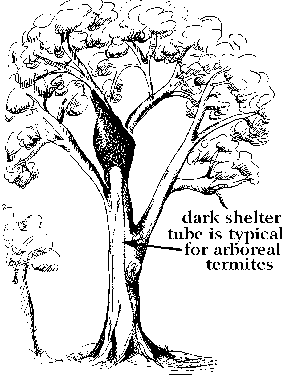
General
Information about Termites (3)
Termite Nest
(Termitarium)
go to main menu
The queen, the brood and most of the colony’s individuals live in a so-called termitarium (plural: termitaria). It is composed of mud that is sometimes as hard as concrete and a paper-like substance made from chewed wood. The conditions inside the nest are dark, moist and cool and suit the requirements of the mostly blind unpigmented termites with their soft cuticles. Runways or galleries are built by the workers radially from the nest in all directions and connect the termitarium with sites where the colony gathers food.

Mound nest
These galleries are either subterranean about 20 to 50 cm deep or are built from mud (mud packs or mud galleries), attached to a stem or other substrates. The termites’ road system can be enormous and reach a radius of 50 to 100 metres around the nest. Each termite species builds its particular type of nest, either a mound nest (shown above) made above the ground, or a subterranean nest in a buried log, a decaying stump or the crown root of a tree, or an arboreal nest attached to a branch or to the stem of a tree. Mound nests can reach a height of up to six metres. The mound nest of the Australian species Amitermes meridionalis is flattened and the tapered sides always orientate towards the north and south. Constructing the nest this way ensures that the inside of the nest is not heated up by the sun since only the narrow sides are exposed to direct sun light. Subterranean nests buried at a depth of 50 cm or even reaching depths of several metres, are invisible and therefore difficult to discover.


Subterranean
(left) and arboreal (right) termite
nest
(drawings reproduced from Hadlington, P., 1992)
go to previous page
go to main menu
© Michael F. Schneider, 1999